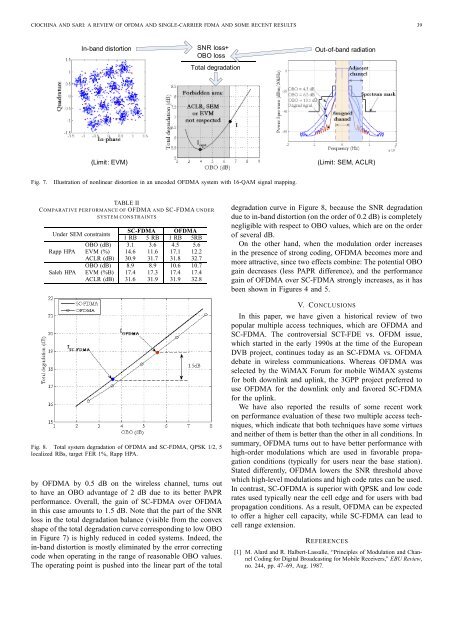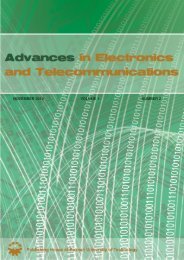channel - Advances in Electronics and Telecommunications
channel - Advances in Electronics and Telecommunications
channel - Advances in Electronics and Telecommunications
You also want an ePaper? Increase the reach of your titles
YUMPU automatically turns print PDFs into web optimized ePapers that Google loves.
CIOCHINA AND SARI: A REVIEW OF OFDMA AND SINGLE-CARRIER FDMA AND SOME RECENT RESULTS 39<br />
������������������ ���������<br />
���������������������<br />
��������<br />
�����������������<br />
������������ ������������������<br />
Fig. 7. Illustration of nonl<strong>in</strong>ear distortion <strong>in</strong> an uncoded OFDMA system with 16-QAM signal mapp<strong>in</strong>g.<br />
TABLE II<br />
COMPARATIVE PERFORMANCE OF OFDMA AND SC-FDMA UNDER<br />
SYSTEM CONSTRAINTS<br />
Under SEM constra<strong>in</strong>ts<br />
SC-FDMA<br />
1 RB 5 RB<br />
OFDMA<br />
1 RB 5RB<br />
OBO (dB) 3.1 3.6 4.5 5.6<br />
Rapp HPA EVM (%) 14.6 11.6 17.1 12.2<br />
ACLR (dB) 30.9 31.7 31.8 32.7<br />
OBO (dB) 8.9 8.9 10.6 10.7<br />
Saleh HPA EVM (%B) 17.4 17.3 17.4 17.4<br />
ACLR (dB) 31.6 31.9 31.9 32.8<br />
Fig. 8. Total system degradation of OFDMA <strong>and</strong> SC-FDMA, QPSK 1/2, 5<br />
localized RBs, target FER 1%, Rapp HPA.<br />
by OFDMA by 0.5 dB on the wireless <strong>channel</strong>, turns out<br />
to have an OBO advantage of 2 dB due to its better PAPR<br />
performance. Overall, the ga<strong>in</strong> of SC-FDMA over OFDMA<br />
<strong>in</strong> this case amounts to 1.5 dB. Note that the part of the SNR<br />
loss <strong>in</strong> the total degradation balance (visible from the convex<br />
shape of the total degradation curve correspond<strong>in</strong>g to low OBO<br />
<strong>in</strong> Figure 7) is highly reduced <strong>in</strong> coded systems. Indeed, the<br />
<strong>in</strong>-b<strong>and</strong> distortion is mostly elim<strong>in</strong>ated by the error correct<strong>in</strong>g<br />
code when operat<strong>in</strong>g <strong>in</strong> the range of reasonable OBO values.<br />
The operat<strong>in</strong>g po<strong>in</strong>t is pushed <strong>in</strong>to the l<strong>in</strong>ear part of the total<br />
degradation curve <strong>in</strong> Figure 8, because the SNR degradation<br />
due to <strong>in</strong>-b<strong>and</strong> distortion (on the order of 0.2 dB) is completely<br />
negligible with respect to OBO values, which are on the order<br />
of several dB.<br />
On the other h<strong>and</strong>, when the modulation order <strong>in</strong>creases<br />
<strong>in</strong> the presence of strong cod<strong>in</strong>g, OFDMA becomes more <strong>and</strong><br />
more attractive, s<strong>in</strong>ce two effects comb<strong>in</strong>e: The potential OBO<br />
ga<strong>in</strong> decreases (less PAPR difference), <strong>and</strong> the performance<br />
ga<strong>in</strong> of OFDMA over SC-FDMA strongly <strong>in</strong>creases, as it has<br />
been shown <strong>in</strong> Figures 4 <strong>and</strong> 5.<br />
V. CONCLUSIONS<br />
In this paper, we have given a historical review of two<br />
popular multiple access techniques, which are OFDMA <strong>and</strong><br />
SC-FDMA. The controversial SCT-FDE vs. OFDM issue,<br />
which started <strong>in</strong> the early 1990s at the time of the European<br />
DVB project, cont<strong>in</strong>ues today as an SC-FDMA vs. OFDMA<br />
debate <strong>in</strong> wireless communications. Whereas OFDMA was<br />
selected by the WiMAX Forum for mobile WiMAX systems<br />
for both downl<strong>in</strong>k <strong>and</strong> upl<strong>in</strong>k, the 3GPP project preferred to<br />
use OFDMA for the downl<strong>in</strong>k only <strong>and</strong> favored SC-FDMA<br />
for the upl<strong>in</strong>k.<br />
We have also reported the results of some recent work<br />
on performance evaluation of these two multiple access techniques,<br />
which <strong>in</strong>dicate that both techniques have some virtues<br />
<strong>and</strong> neither of them is better than the other <strong>in</strong> all conditions. In<br />
summary, OFDMA turns out to have better performance with<br />
high-order modulations which are used <strong>in</strong> favorable propagation<br />
conditions (typically for users near the base station).<br />
Stated differently, OFDMA lowers the SNR threshold above<br />
which high-level modulations <strong>and</strong> high code rates can be used.<br />
In contrast, SC-OFDMA is superior with QPSK <strong>and</strong> low code<br />
rates used typically near the cell edge <strong>and</strong> for users with bad<br />
propagation conditions. As a result, OFDMA can be expected<br />
to offer a higher cell capacity, while SC-FDMA can lead to<br />
cell range extension.<br />
REFERENCES<br />
[1] M. Alard <strong>and</strong> R. Halbert-Lassalle, “Pr<strong>in</strong>ciples of Modulation <strong>and</strong> Channel<br />
Cod<strong>in</strong>g for Digital Broadcast<strong>in</strong>g for Mobile Receivers,” EBU Review,<br />
no. 244, pp. 47–69, Aug. 1987.







